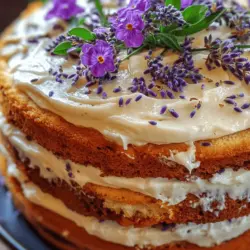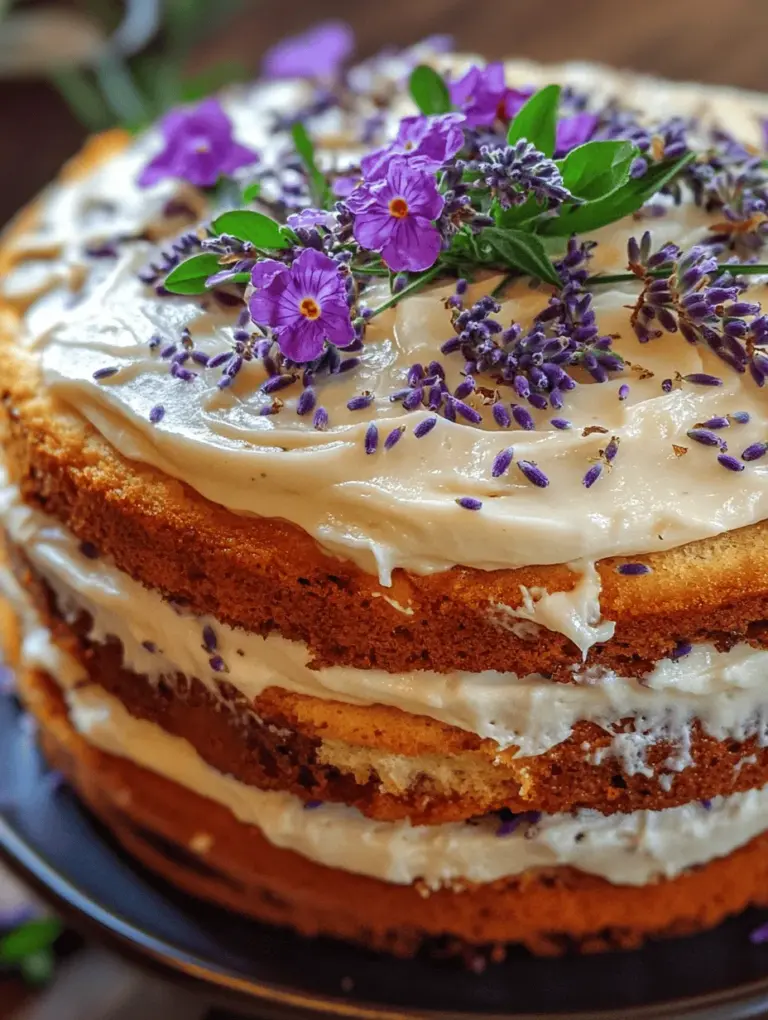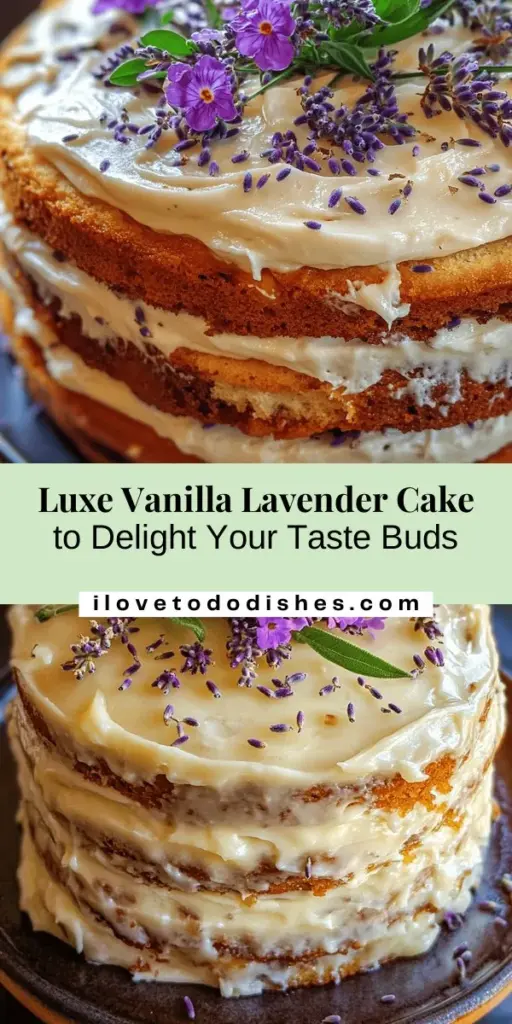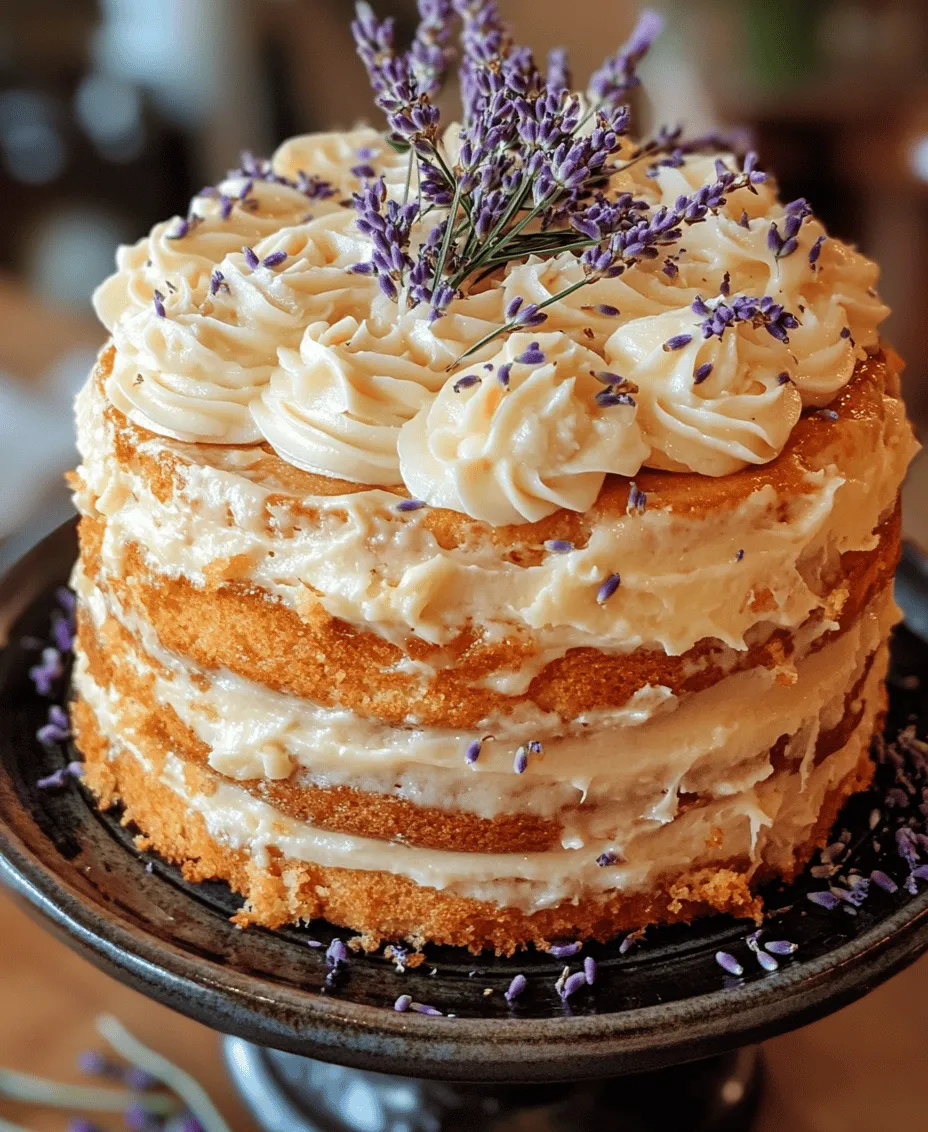Introduction
Welcome to the world of delightful baking, where unique flavor combinations elevate traditional recipes to new heights. Today, we’ll explore the exquisite *Divine Vanilla Bean and Lavender Cake*, a dessert that beautifully marries the creamy, sweet notes of vanilla with the floral elegance of culinary lavender. This captivating cake is not just a feast for the taste buds; it also enchants the senses with its aromatic fragrance, making it a perfect centerpiece for any occasion.
In recent years, the use of lavender in baking has seen a remarkable rise in popularity. This fragrant herb, traditionally known for its calming properties, has found its way into the culinary world, adding a touch of sophistication and a hint of whimsy to various desserts. Lavender’s delicate flavor profile pairs wonderfully with the rich, sweet notes of vanilla, creating a cake that is both refreshing and indulgent. Whether you’re hosting a lavish wedding, a quaint tea party, or celebrating a special milestone, this cake is sure to impress your guests and leave a lasting impression.
Understanding the Ingredients
To create the *Divine Vanilla Bean and Lavender Cake*, it’s essential to understand the roles of each ingredient that contributes to its remarkable flavor and texture. Let’s delve into the key components of this cake, starting with the foundation—flour.
All-Purpose Flour
All-purpose flour is a staple in many baking recipes and serves as the backbone of this cake. Its moderate protein content provides the necessary structure while still allowing for a tender crumb. The versatility of all-purpose flour makes it an excellent choice, as it can accommodate various baked goods. In this recipe, it ensures that our cake rises beautifully without becoming too dense.
Granulated Sugar
Sugar does more than just add sweetness; it plays a crucial role in moisture retention and texture. Granulated sugar helps to create a tender crumb by interacting with the fat in the butter, leading to a light and airy cake. Additionally, sugar contributes to the cake’s golden-brown color as it caramelizes during baking, enhancing both its flavor and visual appeal.
Unsalted Butter
Using unsalted butter is vital for achieving the perfect balance of flavors in this cake. It allows for precise control over the salt content, ensuring that the cake is not overly salty. The richness of unsalted butter adds depth to the flavor profile while also contributing to the cake’s moist texture. When creamed with sugar, butter helps to incorporate air into the batter, which is essential for achieving a light, fluffy cake.
Whole Milk
Whole milk is a key ingredient that contributes to the cake’s crumb structure and moisture content. The fat in whole milk enhances the cake’s richness and prevents it from becoming dry. Additionally, the proteins in milk help to create a tender texture, making each bite melt in your mouth. For the best results, it’s crucial to use milk at room temperature, as this helps to create a smooth and well-combined batter.
Eggs
Eggs serve multiple purposes in baking; they act as a binding agent, adding structure to the cake, while also providing moisture. The proteins in eggs coagulate during baking, helping the cake to rise and hold its shape. They also contribute to the overall flavor and richness of the cake. For this recipe, it’s important to use large eggs, ideally at room temperature, to ensure even mixing and optimal incorporation into the batter.
Baking Powder
Baking powder is a chemical leavening agent that plays a critical role in helping the cake rise. It contains a combination of an acid and a base that reacts when liquid is added, producing carbon dioxide gas. This gas creates bubbles in the batter, resulting in a light and fluffy cake. It’s important to use fresh baking powder to achieve the best leavening effect, so always check the expiration date before baking.
Pure Vanilla Extract and Vanilla Bean
No vanilla cake would be complete without the rich flavor of vanilla. In this recipe, we incorporate both pure vanilla extract and vanilla bean to create a complex and layered flavor profile. Pure vanilla extract provides a strong vanilla flavor, while the tiny specks of vanilla bean add visual appeal and an additional depth of flavor. Together, they enhance the cake’s sweetness and aromatic qualities, making it truly divine.
Culinary Dried Lavender
The star of this recipe, culinary dried lavender, is what sets this cake apart from conventional vanilla cakes. Known for its fragrant, floral flavor, lavender adds a sophisticated twist that elevates the overall experience. When used in moderation, dried lavender can impart a subtle flavor that complements the sweetness of the vanilla without overpowering it. Additionally, the aroma of lavender can create a calming atmosphere, making it an ideal choice for special occasions.
Salt
While it may seem counterintuitive, salt is a crucial ingredient in baking. It enhances the sweetness of the cake and balances the flavors, ensuring that the cake is not overly sweet. A small pinch of salt can also heighten the overall flavor profile, making each bite more enjoyable. In this recipe, a light sprinkle of salt will bring out the best in the vanilla and lavender.
Prepping for Baking
Before you dive into mixing and baking, proper preparation is key to achieving the best results. Here’s a step-by-step guide to ensure that your *Divine Vanilla Bean and Lavender Cake* turns out perfectly.
Preheating the Oven
Start by preheating your oven to 350°F (175°C). Preheating is essential as it ensures that the cake bakes evenly from the moment it goes in the oven. An adequately heated oven helps to set the structure of the cake quickly, leading to a lighter texture.
Preparing the Cake Pans
To ensure easy removal of the cake after baking, it’s important to properly grease and flour your cake pans. Here’s how to do it:
1. Grease the Pans: Use unsalted butter or a non-stick cooking spray to coat the interior surfaces of your cake pans. Make sure to cover all areas, including the edges, to prevent sticking.
2. Flour the Pans: After greasing, sprinkle a small amount of all-purpose flour into each pan. Tilt and tap the pans to distribute the flour evenly across the greased surfaces. This creates a barrier between the cake and the pan, allowing for easy release once the cake is baked.
3. Remove Excess Flour: Gently tap the pans upside down to remove any excess flour. This step is important to avoid having floury spots on the cake’s surface.
Crushing Dried Lavender
To maximize the flavor and aroma of the lavender in your cake, consider crushing the dried lavender before adding it to the batter. Crushing releases the essential oils within the lavender buds, intensifying its fragrance and flavor. Here’s how to do it:
1. Use a Mortar and Pestle: Place the dried lavender buds in a mortar and use the pestle to gently crush them. Aim for a coarse consistency—too fine can lead to a bitter flavor.
2. Alternative Method: If you don’t have a mortar and pestle, you can place the dried lavender in a resealable plastic bag and use a rolling pin to crush it. This method works well and allows for easy cleanup.
3. Measure Carefully: When adding crushed lavender to your batter, be cautious not to overdo it. A little goes a long way, and you want the lavender to enhance rather than overpower the vanilla.
Now that you’re familiar with the ingredients and the initial preparation steps, you’re well on your way to creating a stunning and flavorful *Divine Vanilla Bean and Lavender Cake*. This cake promises to be a delightful addition to your celebration, enchanting all who are fortunate enough to indulge in its light and fragrant layers. Stay tuned for the next part, where we’ll dive into the detailed mixing and baking instructions!
Soaking Lavender in Milk for a Stronger Flavor Profile
For those who prefer a more pronounced lavender flavor in their cake, soaking dried culinary lavender in milk is an effective method to infuse the essence into your cake batter. Begin by measuring about 1-2 tablespoons of dried lavender buds. Place them in a small saucepan with 1 cup of milk and heat over medium-low until the milk is warm but not boiling. Remove from heat, cover, and let the mixture steep for at least 30 minutes. This technique allows the lavender to release its aromatic oils, creating a more robust flavor that will beautifully complement the vanilla bean. Once steeped, strain the milk to remove the lavender buds before incorporating it into your batter.
Mixing and Baking the Cake
With the lavender-infused milk prepared, it’s time to focus on mixing and baking the cake. Each step in this process is essential for achieving the ideal texture and flavor.
Mixing Dry Ingredients
Start by gathering your dry ingredients: all-purpose flour, baking powder, baking soda, and a pinch of salt. Sift these ingredients together in a medium bowl. Sifting is crucial as it aerates the flour, removing any lumps and ensuring a uniform consistency. This step also helps to evenly distribute the leavening agents, allowing the cake to rise properly during baking. Once sifted, set the dry ingredients aside while you prepare the wet ingredients.
Creaming Butter and Sugar
In a large mixing bowl, add your softened unsalted butter and granulated sugar. Using a stand mixer or a hand mixer, beat the butter and sugar together on medium speed. The goal here is to achieve a light and fluffy texture, which typically takes about 3-5 minutes. This process incorporates air into the butter, which helps the cake rise during baking. You’ll know you’ve reached the desired texture when the mixture is pale in color and has increased in volume.
Incorporating Eggs Gradually
Next, add the eggs one at a time to the creamed butter and sugar mixture, mixing well after each addition. This gradual incorporation is essential as it allows each egg to fully blend into the batter, ensuring an even distribution of moisture and fat. If you add the eggs too quickly, you risk the batter becoming curdled, which can affect the cake’s final texture.
Alternating Dry and Wet Ingredients
Now it’s time to combine the dry ingredients with the wet ingredients. Begin by adding about one-third of the dry mixture to the butter and sugar mixture, followed by half of the lavender-infused milk. Mix until just combined. Repeat this process, alternating between the dry ingredients and the wet, finishing with the dry ingredients. This method helps maintain the cake’s structure and prevents overmixing, which can lead to a dense cake.
Folding in the Lavender
Once your batter is smooth, gently fold in the remaining lavender buds (if desired) using a spatula. This method ensures even distribution without overmixing, which can deflate the batter. Be careful not to overwork the batter at this stage; gentle folding will help retain the lightness that you’ve created.
Baking Tips
Preheat your oven to 350°F (175°C) and prepare your cake pans by greasing them and lining the bottoms with parchment paper. Divide the batter evenly between the prepared pans and smooth the tops with a spatula. Bake for 25-30 minutes, or until a toothpick inserted into the center comes out clean. Visual cues to look for include a golden-brown color on the top and edges of the cake, as well as a slight spring back when lightly pressed.
Cooling and Decorating the Cake
Once baked, remove the cakes from the oven and allow them to cool in the pans for about 10-15 minutes.
Importance of Cooling
Proper cooling is critical to maintaining the cake’s structure. If you attempt to remove the cakes from their pans when they are still hot, they may break or become soggy. After the initial cooling period, gently run a knife around the edges of the pans, then invert the cakes onto a wire rack to cool completely.
Optional Lavender-Infused Simple Syrup
For added moisture and flavor, consider making a lavender-infused simple syrup. Combine equal parts sugar and water with a tablespoon of dried lavender in a saucepan. Heat until the sugar dissolves, then let it steep for 30 minutes. Once cooled, use this syrup to lightly brush the tops of the cakes before frosting. This step not only enhances the flavor but also helps keep the cake moist.
Frosting Options
When it comes to frosting, several options pair beautifully with the Divine Vanilla Bean and Lavender Cake. A classic vanilla buttercream creates a sweet and creamy contrast, while a cream cheese frosting adds a tangy richness that complements the floral notes. If you prefer a lighter option, consider a whipped cream frosting, which will keep the cake feeling airy and fresh.
Decorating the Cake
For decoration, consider a simple yet elegant approach. A smooth layer of frosting on the top and sides of the cake creates a classic look. To elevate it further, garnish with fresh lavender sprigs, edible flowers, or delicate sugar pearls. You can also sprinkle some extra lavender buds on top for a pop of color and additional aroma.
Serving Suggestions
The Divine Vanilla Bean and Lavender Cake is versatile enough for a variety of occasions.
Ideal Occasions
This cake is perfect for spring and summer gatherings, bridal showers, tea parties, or even as a delightful dessert for a birthday celebration. Its light flavor profile makes it an ideal choice for afternoon tea or as a refreshing finish to a summer meal.
Pairing Suggestions
Pair this cake with a cup of fragrant herbal tea, such as chamomile or earl grey, to enhance the lavender notes. For a more celebratory occasion, consider serving it with a glass of champagne or a light prosecco, which will complement the floral flavors beautifully.
Portioning Tips
When serving at gatherings, consider cutting the cake into smaller, bite-sized pieces. This not only allows guests to enjoy a taste but also encourages them to try multiple desserts. A cake server or a sharp knife will help you achieve clean cuts, ensuring each slice is visually appealing.
Conclusion
The Divine Vanilla Bean and Lavender Cake is a delightful combination of flavors and aromas that transports you to a blooming garden with each bite. The careful balance of sweet vanilla and fragrant lavender makes it a unique treat that’s sure to impress your guests.
Baking this cake is not just about following a recipe; it’s about embracing the joy of creating something beautiful and delicious. Feel free to experiment with flavors by adding citrus zest, swapping lavender for other herbs, or incorporating different frostings to suit your taste.
In sharing this cake with loved ones, you’re not just offering a dessert; you’re sharing a memorable experience filled with warmth and creativity. So roll up your sleeves and embark on this baking adventure, and savor the joy that comes from making and sharing this exquisite Divine Vanilla Bean and Lavender Cake.



